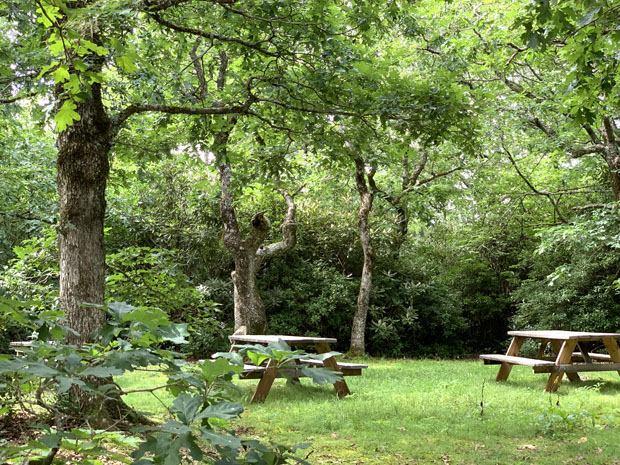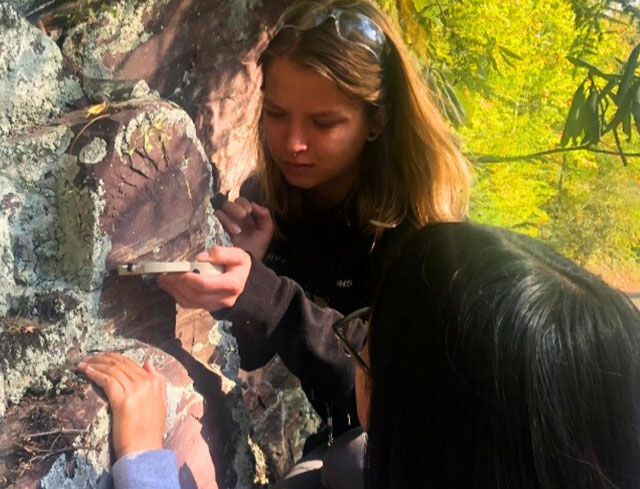Left Alone Places
02 Feb 2023
The Mountain inducted into the Old Growth Forest Network
Story by LISA GRAY YOUNGBLOOD
Photos by SARAH ADLOO

Dr. Joan Maloof is a scientist and university professor who came to learn three devastating truths. First, almost all of America’s original forests have been logged or otherwise destroyed, leaving less than 1% in the East and 5% in the West. Second, most Americans will never see an old growth forest. Third, there is no national organization or governmental agency working to protect the remaining ancient forests or preserve recovering forests. These were truths she could not accept, so she left the lab and the classroom to become an advocate, first reaching people with her words, ultimately publishing five books, two of which focus on ancient trees, and then founding The Old Growth Forest Network (“The Network”) in 2007.
The mission of The Network is ambitious. It aims to identify and protect one forest in each county of the United States where forests could grow (2,370 of 3,140 counties) and to educate the public on where they are located. Dr. Maloof is not opposed to harvesting trees for board and fiber, but as an ecologist she knows that “when we do, we are sacrificing biodiversity. A certain amount of sacrifice may be necessary—all animals influence their surroundings--but there should also be places left to nature’s processes if only so we may witness how nature works; if only so we can enjoy the beauty and wonder of such places. It is these left-alone places that are refuges to birds, and butterflies and animals of all kinds … and that clean our air and water and protect our climate.”
In 2020, Dr. Sarah Adloo, a conservation scientist specializing in environmental psychology and social sciences, heard Dr. Maloof’s call. She had long been a fan of Dr. Maloof’s work and had used many of her books as teaching tools while at the University of Georgia. So, when a small forest in her own neighborhood was inducted into The Network, Adloo knew the direction her life would take. Not long after, she became The Network’s Executive Director.
“Thus far, 184 forests have been inducted,” Adloo explains. “There remains much work to be done. The Network is searching for both existing and future old growth forests, and we need the public’s help.” A future old growth forest would be a native forest that has been logged in the past but could be preserved and protected going forward, ultimately serving as an old growth forest for future generations.
One of the first forests Adloo inspected was at The Mountain Retreat and Learning Center (“The Mountain”) in Scaly Mountain. The Mountain is a retreat, camp and learning center founded upon Universalist Unitarian principles that celebrate the inherent worth and dignity of every individual and respect the interdependent web of all existence. It is, as USA Today reported in 1999, one of the ten best places in the country to “renew the soul.” Many guests have referred to it as magical or healing, and it is right here in our backyard.
When The Mountain was founded in 1979, the founders knew the land was beautiful, and they vowed to serve as its environmental steward. In the process of setting up the space and turning it from camp to retreat center, they had to cut down a single tree that stood in the middle of the parking lot. Once the tree was cut, they could see the closeness in the rings of the coin. To their count, well over 500, which meant the tree was over 500 years old.
Immediately The Mountain contacted a dendrologist at Clemson University to learn more. Similar trees lay throughout the property. Was it possible they were all ancient?
It most certainly was. The Mountain learned it stood amid an ancient and sacred forest. The fact that the age of this forest was not readily apparent is significant, Adloo explains. “It is a great example of how diverse old forests can be. Most people imagine giant Redwoods and Sequoias when they think about an old growth forest, but our oldest forests take so many forms across the country. Because of the intense winds and harsh environment of a rocky mountain top, these trees are not giants but rather small, gnarled, wizened old trees. Native, mature forests are so important for the climate, biodiversity, and our connection to nature that we need to make sure we recognize and protect those that remain, especially when they may not be so obvious.”
The Mountain was officially inducted into The Network in 2021 and is one of only three sites in North Carolina. The trees that make up the forest are Dwarf White Oaks. “The Mountain is situated in a temperate rainforest atop 4200 feet of granite with only about three inches of topsoil,” explains Beverly Cree, Development Director and long-term activist at The Mountain. The roots of these trees actually dig into the granite, finding cracks and crevices to thread through, absorbing nutrients and garnering the strength of the rock itself. “It’s a great metaphor for life,” says Cree. “Persevere. Dig your roots deep. Connect to the earth.”
The Mountain knows all about connecting with the earth. In 2014, it joined the Compassion Tree Project, a subgroup of the 2009 International Charter for Compassion. The mission of the Compassion Tree Project is to plant 7.7 billion trees worldwide, one for each person in the world. The very first of these trees was an apple tree planted in the food forest of The Mountain. It was planted by a group of multicultural children, including indigenous Native Americans.
For more information about the Old Growth Forest Network, visit oldgrowthforest.net
For more information about The Mountain, visit themountainrlc.org













